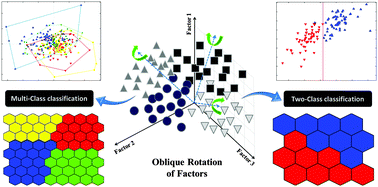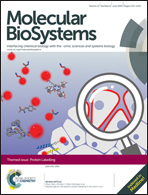Oblique rotation of factors: a novel pattern recognition strategy to classify fluorescence excitation–emission matrices of human blood plasma for early diagnosis of colorectal cancer†
Abstract
Colorectal cancer (CRC) ranks high in both men and women, accounting for about 13% of all cancers. In this study, a novel pattern recognition strategy is proposed to improve early diagnosis of CRC through visualizing the relationship between different spectral patterns in a case-control research. Partial least squares-discriminant analysis (PLS-DA) and supervised Kohonen network (SKN) were used to classify the fluorescence excitation–emission matrices (EEMs) from 289 human blood plasma samples containing CRC patients, adenomas tumor, other non-malignant findings and healthy individuals. To obtain optimal factors, oblique rotation (OR) and genetic algorithm (GA) were used to rotate the factors by optimizing transformation matrix elements. Transformed factors were introduced to SKN to build a classification model and the model performance was examined via comparison with a common classifier; PLS-DA. Classification models were built for CRC-healthy and adenomas-healthy samples and the best results were obtained through applying GA–OR on PLS factors and introducing them to the classifiers. Non-error rates for SKN and PLS-DA models assisted with GA (for selecting more informative PLS factors) and OR were equal to 0.97 and 0.95 in cross validation and 0.93 and 0.90 for prediction of the external test set, respectively. Moreover, according to the acceptable results for adenomas-healthy cases using optimal factors, CRC can be diagnosed in early stages. Combining classifiers and optimal factors proved to be efficient for distinguishing healthy and malignant samples, and OR can significantly improve performance of the classification model.


 Please wait while we load your content...
Please wait while we load your content...